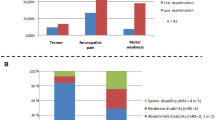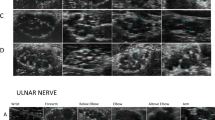Abstract
To report the frequency of the different patterns of sensory and motor electrophysiological demyelination distribution in patients with anti-MAG neuropathy in comparison with patients with IgM neuropathy without MAG reactivity (IgM-NP). Thirty-five anti-MAG patients at early disease stage (20.1 months) were compared to 23 patients with IgM-NP; 21 CIDP patients and 13 patients with CMT1a neuropathy were used as gold standard neuropathies with multifocal and homogeneous demyelination, respectively. In all groups, standard motor and sensory electrophysiological parameters, terminal latency index and modified F ratio were investigated. Motor electrophysiological demyelination was divided in four profiles: distal, homogeneous, proximal, and proximo-distal. Distal sensory and sensorimotor demyelination were evaluated. Anti-MAG neuropathy is a demyelinating neuropathy in 91 % of cases. In the upper limbs, reduced TLI is more frequent in anti-MAG neuropathy, compared to IgM-NP. But, predominant distal demyelination of the median nerve is encountered in only 43 % of anti-MAG neuropathy and is also common in IgM-NP (35 %). Homogeneous demyelination was the second most frequent pattern (31 %). Concordance of electrophysiological profiles across motor nerves trunks is low and median nerve is the main site of distal motor conduction slowing. Reduced sensory conduction velocities occurs in 14 % of patients without evidence of predominant distal slowing. Simultaneous sensory and motor distal slowing was more common in the median nerve of anti-MAG neuropathy than IgM-NP. Electrophysiological distal motor demyelination and sensory demyelination are not a distinctive feature of anti-MAG reactivity. In anti-MAG neuropathy it is mainly found in the median nerve suggesting a frequent nerve compression at wrist.
Similar content being viewed by others
References
Chassande B, Leger JM, Ben Younes-Chennoufi A et al (1998) Peripheral neuropathy associated with IgM monoclonal gammopathy: correlations between M-protein antibody activity and clinical/electrophysiological features in 40 cases. Muscle Nerve 21:55–62
Joint Task Force of the EFNS and the PNS (2010) European Federation of Neurological Societies/Peripheral Nerve Society Guideline on management of paraproteinemic demyelinating neuropathies. Report of a Joint Task Force of the European Federation of Neurological Societies and the Peripheral Nerve Society–first revision. J Periph Nerv Syst 15:185–195
Franssen H, Notermans NC (2006) Length dependence in polyneuropathies associated with IgM gammopathy. Ann Neurol 59:365–371
Barohn RJ, Kissel JT, Warmolts JR et al (1989) Chronic inflammatory demyelinating polyradiculoneuropathy: clinical characteristics, course and recommendations for diagnostic criteria. Arch Neurol 46:878–884
Kaku DA, Parry GJ, Malamut R et al (1993) Nerve conduction studies in Charcot-Marie-Tooth polyneuropathy associated with segmental duplication of chromosome 17. Neurology 43:1806–1808
Kaku DA, England JD, Sumner AJ (1994) Distal accentuation of conduction slowing in polyneuropathy associated with antibodies to myelin-associated glycoprotein and sulfated glucuronyl paragloboside. Brain 117:941–947
Attarian S, Azulay JP, Boucraut J et al (2001) Terminal latency index and modified F ratio in distinction of chronic demyelinating neuropathies. Clin Neurophysiol 112:457–463
Maisonobe Th, Chassande B, Verin M et al (1996) Chronic dysimmune demyelinating polyneuropathy: a clinical and electrophysiological study of 93 patients. J Neurol Neurosurg Psychiatry 61:36–42
Capasso M, Torrieri F, Di Muzio A et al (2002) Can electrophysiology differentiate polyneuropathy with anti-MAG/SGPG antibodies from chronic inflammatory demyelinating polyneuropathy? Clin Neurophysiol 113:346–353
Lupu VD, Mora CA, Dambrosia J et al (2007) Terminal latency index in neuropathy with antibodies against myelin-associated glycoproteins. Muscle Nerve 35:196–202
Magy L, Kaboré R, Mathis S, Lebeau P, Ghorab K, Caudie C et al (2015) Heterogeneity of polyneuropathy associated with anti-MAG antibodies. J Immunol Res 2015:450391
Bromberg MB, Albers JW (1993) Patterns of sensory nerve conduction abnormalities in demyelinating and axonal peripheral nerve disorders. Muscle Nerve 16:262–266
Norris FH, Sang U, Sachais B, Caray M (1979) Trial of baclofen in amyotrophic lateral sclerosis. Arch Neurol 36:715–716
Merkies I, Schmitz P, Van Der Mechè F, Van Doorn P, Inflammatory Neuropathy Cause and Treatment (INCAT) Group (2000) Psychometric evaluation of a new sensory scale in immune-mediated polyneuropathies. Neurology 54:943–949
Joint Task Force of the EFNS and the PNS (2010) European Federation of Neurological Societies/Peripheral Nerve Society Guideline on management of chronic inflammatory demyelinating polyradiculoneuropathy: report of a joint task force of the European Federation of Neurological Societies and the Peripheral Nerve Society—first revision. J Peripher Nerv Syst 15:1–9
Birouk N, Gouider R, Le Guern E et al (1997) Charcot-Marie-Tooth disease type 1A with 17p11.2 duplication. Clinical and electrophysiological phenotype study and factors influencing disease severity in 119 cases. Brain 120:813–823
Luigetti M, Padua L, Mazza S, Rossini PM, Sabatelli M, Lo Monaco M et al (2013) Clinical—neurophysiological correlations in a series of patients with IgM-related neuropathy. Clin Neurophysiol 124:1899–1903
Kuijf ML, Eurilings M, Tio-Gillen AP et al (2009) Detection of anti-MAG antibodies in polyneuropathy associated with IgM monoclonal gammopathy. Neurology 73:688–695
Dalakas MC (2010) Pathogenesis and treatment of anti-MAG neuropathy. Curr Treat Options Neurol 12:71–83
Gosselin S, Kyle RA, Dyck PJ (1991) Neuropathy associated with monoclonal gammopathies of undetermined significance. Ann Neurol 30:54–61
Notermans NC, Wokke JHJ, Lokhorst HM et al (1994) Polyneuropathy associated with monoclonal gammopathy of undetermined significance. A prospective study of the prognostic value of clinical and laboratory abnormalities. Brain 117:1385–1393
Ponsford S, Willison H, Veitch J et al (2000) Long-term clinical and neurophysiological follow-up of patients with peripheral neuropathy associated with benign monoclonal gammopathy. Muscle Nerve 23:164–174
Alkhawajah NM, Dunnigan SK, Bril V (2014) Comparison of monoclonal gammopathy of undetermined significance-associated neuropathy and chronic inflammatory demyelinating polyneuropathy patients. J Neurol 261:1485–1491
Latov N, Hays AP, Sherman WH (1988) Peripheral neuropathy and anti-MAG antibodies. CRC Crit Rev Neurobiol 3:301–332
Pestronk A, Li F, Griffin J, Feldman EL et al (1991) Polyneuropathy syndromes associated with serum antibodies to sulfatide and myelin-associated glycoprotein. Neurology 41:357–362
Faber CG, Notermans NC, Wokke JHJ et al (2009) Entrapment in anti myelin-associated glycoprotein neuropathy. J Neurol 256:620–624
Ropper AH, Gorson KC (1988) Neuropathies associated with paraproteinemia. N Engl J Med 338:1601–1607
Tai TW, Wu CY, Su FC et al (2012) Ultrasonography for the diagnosing carpal tunnel syndrome: a meta-analysis of diagnosis test accuracy. Ultrasound Med Biol 38:1121–1128
Lucchetta M, Padua L, Granata G et al (2015) Nerve ultrasound findings in neuropathy associated with anti-myelin-associated glycoprotein antibodies. Eur J Neurol 22:193–202
Coccito D, Isoardo G, Ciaramitaro P et al (2002) Neurophysiological determination of the carpal tunnel syndrome in patients with chronic demyelinating polyneuropathy. J Periph Nerv Syst 7:73
Dyck PJ, Kratz KM, Karnes JL et al (1993) The prevalence by staged severity of various types of diabetic neuropathy, retinopathy, and nephropathy in a population-based cohort: the Rochester Diabetic Neuropathy Study. Neurology 43:817–824
Tankisi H, Pugdahl K, Johnsen B, Fuglsang-Frederiksen A (2007) Correlations of nerve conduction measures in axonal and demyelinating polyneuropathies. Clin Neurophysiol 118:2383–2392
Feinberg DM, Preston DC, Shefner JM, Logigian EL (1999) Amplitude-dependent slowing of conduction in amyotrophic lateral sclerosis and polyneuropathy. Muscle Nerve 22:937–940
Author information
Authors and Affiliations
Corresponding author
Ethics declarations
Conflicts of interest
The other authors declare that they have no conflict of interest.
Funding
Dr. Lozeron received a speaker honorarium from Pfizer, Astellas and Sanofi and received travel grants from CSL Behring.
Electronic supplementary material
Below is the link to the electronic supplementary material.
Rights and permissions
About this article
Cite this article
Lozeron, P., Ribrag, V., Adams, D. et al. Is distal motor and/or sensory demyelination a distinctive feature of anti-MAG neuropathy?. J Neurol 263, 1761–1770 (2016). https://doi.org/10.1007/s00415-016-8187-z
Received:
Revised:
Accepted:
Published:
Issue Date:
DOI: https://doi.org/10.1007/s00415-016-8187-z




